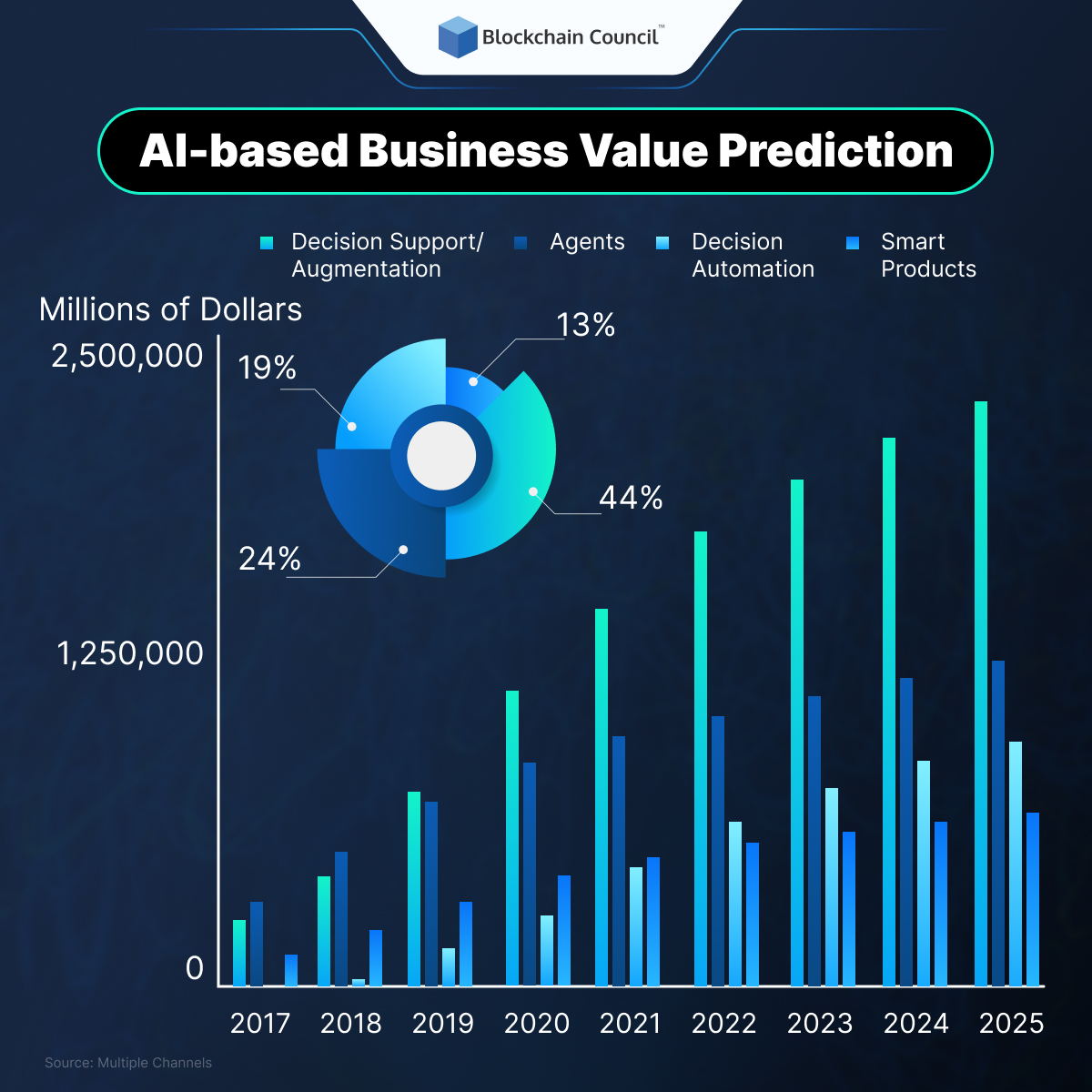
- Blockchain Council
- May 10, 2023
Summary:
- AI can help detect and prevent fraud in financial transactions by identifying suspicious activities and flagging them for further investigation.
- It can assist with risk management by analyzing large datasets and identifying potential risks before they become problematic.
- Trading algorithms powered by AI can make faster and more accurate decisions based on market trends and real-time data.
- AI can improve customer service by providing personalized recommendations and solutions based on customer data.
- It can help financial institutions comply with regulations by automating compliance checks and monitoring activities to reduce the risk of non-compliance.
- AI can reduce operational costs and improve profitability by automating routine tasks and optimizing business processes.
- By analyzing large amounts of data, AI can provide valuable insights that can help financial institutions make better-informed decisions.
- Implementing AI in finance does come with challenges, such as data privacy concerns and the need for skilled professionals to manage AI systems.
- Nonetheless, financial institutions that embrace AI technology are likely to gain a competitive advantage in the industry.
AI is an essential tool for the banking and finance industry, allowing financial institutions to process large amounts of data faster and more accurately than humans could ever achieve. This ability to analyze vast quantities of data in real time is critical for identifying patterns and trends, detecting fraud and financial crime, and making accurate predictions. This has greatly increased the number of institutions adopting AI into their services.
The rise of AI in banking also leads to mass hiring, with companies recruiting more data scientists, machine learning engineers, and other technical specialists. In addition, banks are also seeking individuals who possess soft skills, such as critical thinking, problem-solving, and communication, to complement the technical expertise of their AI teams.
AI in Finance: How is it Changing the Game
In recent years, the banking industry has undergone a dramatic digital transformation. Financial institutions have made significant progress quickly despite being associated with rigid approaches and stiff structures. We can take the example of contactless payments introduced just two decades ago. Now, customers can pay for groceries without a card or mobile phone. International transfers can also be completed in seconds without a central unit acting as an intermediary.
The Role of Artificial Intelligence in Banking
Many of these changes are due to the development of artificial intelligence (AI) tools. AI is responsible for increasing processes in banking institutions and apps, from decision-making processes to customer experience. AI has significantly impacted various sector areas, including forecasting and fraud detection.
Leading Innovation in Banking
Interestingly, some Western countries have been slow to embrace these opportunities. In contrast, others, such as Poland and Estonia, have become innovation leaders in banking. In recent years, financial institutions in these countries have introduced innovative tools and strategies in their mobile apps and customer service, setting new global standards.
Impact of COVID-19 on Digital Transformation
The COVID-19 pandemic has also accelerated the digital transformation of banking. As people were forced to stay home, online banking and mobile apps became essential for banking services. According to a survey by McKinsey, more than 75% of customers have increased their use of digital banking services during the pandemic.
Cost Savings for Banks
Adopting AI in banking also presents significant cost savings for financial institutions. The potential aggregate cost savings for banks using AI applications is estimated to be about $447 billion by 2023.
Become a Certified Artificial Intelligence Expert!
Advantages of AI in Finance
AI has numerous advantages, which have motivated many banking firms to invest their resources and implement AI into their services; we will learn about some of the major advantages now.
Enhanced speed and efficiency of financial transactions and analysis
The financial transaction can now be improved by introducing algorithms that can increase the efficiency of transfers in different countries or time zones. Efficiency and analysis are the backbones of the banking industry. They rely on how the individuals employed assess the finances of the institution’s reserves and assets to mitigate risks and make an informed decision. But, this is not possible when a huge chunk of data needs to be analyzed. Hence, using AI can help managers efficiently separate important data from the huge chunk of waste.
Increased accuracy and precision in decision-making and risk management
AI technology has the potential to significantly increase accuracy and precision in decision-making and risk management, particularly in the financial industry. Using machine intelligence algorithms, banks and companies can leverage AI to determine a person’s eligibility for a loan and provide customized solutions. The benefit of using AI in this context is that it can make decisions without bias, resulting in quicker and more precise loan eligibility decisions.
AI can analyze various characteristics to evaluate prospective borrowers, including smartphone data. With this information, AI algorithms can accurately assess borrowers’ creditworthiness and determine the risk associated with lending to them. This can lead to more accurate loan approvals and rejections, minimizing the risk of financial loss for institutions and providing fair opportunities for borrowers.
Reduction of costs through automation and optimization of business processes
Mistakes happen when humans are in charge, which can be a big problem for financial institutions. But there’s a solution: decision management systems (DMS). These systems use smart rules to make sure data is collected correctly and to help solve problems.
To take an example explaining this, DMS can be used during the onboarding process. Let’s say a customer wants to open an account online. Depending on age and income, DMS can show them which accounts they’re eligible for. DMS also reduces the need for employees to review transactions and activities, which saves even more time and money. Plus, because DMS reduces data entry time, employees can focus on more important tasks and feel less stressed.
Role of AI in Different Financial Sectors
Here we will see and understand the role of AI in different financial sectors and how it is impacting them at large.
Consumer Finance
AI effectively prevents fraud and cyberattacks in the finance industry, a major concern for consumers who want secure accounts. Insider Intelligence predicts that online payment fraud losses will increase to $48 billion annually by 2023. AI can analyze data and identify irregularities that humans might miss.
JPMorgan Chase is one bank that has adopted AI to protect its account holders. Consumer banking represents over 50% of Chase’s net income, so preventing fraud is important. Chase uses a proprietary algorithm to detect fraud patterns. When a credit card transaction is processed, details are sent to central computers, determining whether the transaction is fraudulent. Thanks to its use of AI, Chase has high scores in both Security and Reliability, earning it second place in Insider Intelligence’s 2020 US Banking Digital Trust survey.
Personal Finance
AI is becoming increasingly popular in personal finance as consumers seek more control over their financial health. Financial institutions looking to remain competitive are adopting AI to provide services such as personalized wealth management solutions and 24/7 financial guidance through chatbots powered by natural language processing.
Of the early and most innovative examples of AI in personal finance is Capital One’s Eno. Eno was launched in 2017 and became a US bank’s first SMS text-based assistant. Eno utilizes over 12 proactive capabilities to generate insights and anticipate customer needs, such as alerting customers about suspected fraud or notifying them of price hikes in subscription services.
Corporate Finance
In corporate finance, AI is useful for predicting and assessing loan risks, reducing financial crime, and improving loan underwriting. AI can analyze data and spot anomalies that could be missed by human analysts, helping companies to make better decisions and reduce financial risk.
US Bank is one company that has adopted AI in both its middle- and back-office applications. Using deep learning, US Bank analyzes customer data to identify potential fraudulent activity, such as money laundering. According to an Insider Intelligence report, US Bank has doubled its output in detecting fraud compared to traditional systems. This technology helps US Bank to identify bad actors and prevent financial crime, which is crucial for maintaining the trust of its customers.
FinTech
Banks are under pressure to improve their digital services due to the growing demand from consumers and competition from tech-savvy startups. To meet the needs of younger customers, banks are increasing their IT and AI budgets. Millennials and Gen Zers prefer digital banking channels over visiting branches, with 78% avoiding branches altogether.
The COVID-19 pandemic accelerated this trend, with stay-at-home orders leading consumers to seek self-service options. As a result, Insider Intelligence predicts that online and mobile banking adoption in the US will increase to 72.8% and 58.1%, respectively, by 2024. To stay competitive in this evolving industry, banks must implement AI technologies.
Usages of AI in Finance
The main reason for the increasing usage of AI in finance is its flexibility and intangibility, which needs good and skilled developers to integrate. Hence, learning the technology’s main uses to frame your learning to suit that goal is important.
Trading and Investment Management
1. Investment Software for Recommendations
Banks are always looking for profitable investment opportunities beyond just interest income. They rely on investment software to provide recommendations that match their risk appetite. This helps them make informed investment decisions and earn healthy returns.
2. Accurate Evaluation of Client Proposals
Industry-specific information can be difficult to understand, but investment software can evaluate client funding proposals accurately. It considers various factors and accommodates more variables, making the process easier for human analysts.
3. Hastening the Process of Assessing New Environments
Accessing information can be time-consuming if an institution is interested in investing outside its national borders. However, the right AI software can hasten the process by assessing a new environment quickly and providing insights for investment decisions.
Risk Management and Fraud Detection
1. Decision Management System for Fraud Detection and Audit Documentation
Implementing a Decision Management System can facilitate the early detection of fraudulent activities and comprehensive audit documentation. Third-party auditing can disrupt regular operations when employees must provide missing information or explain entries.
2. The Importance of Artificial Intelligence in Fraud Detection
As financial institutions increase their vigilance against fraudulent activities, fraudsters alter their tactics. They have learned to conduct transactions just under the limit of detection to avoid being flagged for investigation. Criminal activities can go undetected without proper analysis, even when they meet the prescribed requirements. This is an area where artificial intelligence is superior to humans. By analyzing large amounts of data, AI can identify suspicious transactions. In contrast, manual analysis is prone to errors.
3. AI and Money Laundering
The lack of an AI fraud detection system can allow criminals to launder money or finance illegal activities. Money laundering is a significant concern for financial institutions, and the consequences of a breach can be devastating. AI algorithms can detect and alert financial institutions to suspicious transactions indicative of money laundering. This can help prevent banks from becoming unwitting accomplices in criminal activities.
Customer Service and Personalization
Customers today are constantly seeking convenience and easy access to financial services. The introduction of the ATM was a huge success as customers could access banking services outside banking hours. This level of convenience has only led to more innovation. With the rise of smartphones, clients can now open bank accounts, verify their identity, and perform banking transactions from the comfort of their couch.
Efficient KYC and Business Decision Making with DMS
Financial institutions can leverage decision management systems (DMS) to efficiently capture Know Your Customer (KYC) information to reduce turnaround time and eliminate errors. Proper business rules software can enable banks to make faster business decisions and roll out new products and seasonal financial offers on time. In addition, new business decisions or tariff changes can be easily accommodated in the system.
Automated Eligibility and Personal Touch
Using DMS, banks can automate eligibility criteria, meaning clients who do not qualify for a particular product are not frustrated by going through an entire application process only to be rejected. This type of technology provides a personal touch, even with a diverse customer base.
Reducing Turnaround Time and Boosting Trust
Banks can gain the trust and confidence of their clients by reducing turnaround time. DMS can reduce approval times for facilities. It is crucial to minimize errors and ensure that employees do not open accounts erroneously, which can lead to restrictions placed on client accounts and dissatisfaction.
Regulatory Compliance and Reporting
In the financial industry, regulatory compliance and reporting are crucial elements that ensure transparency and accountability. As a heavily regulated industry, financial institutions must ensure that their decisions and actions are fully understood and can be explained in detail. This is where model explainability plays a crucial role.
The Importance of Model Explainability
Financial institutions should be able to explain the decisions made by their algorithms, especially when those decisions significantly impact customers’ lives. To take a common scenario, when an individual is denied a loan, they have the right to request a detailed explanation of the factors that led to that decision, hence the need for a human supervisor.
Choosing the Right Model
While using state-of-the-art techniques might be tempting, a simpler model is often chosen in finance to ensure the analyst can explain the factors that shaped the decision. For instance, logistic regression or a decision tree may be more suitable models than neural network architectures. This is because simpler models can be easily understood and explained.
Model-Agnostic Approaches
The field of explainable AI is developing rapidly, and researchers are working on model-agnostic approaches to explain the decisions of simple and complex models. One such technique is LIME (Local Interpretable Model-agnostic Explanations), which provides interpretable explanations for individual predictions. Another approach is SHAP (Shapley Additive exPlanations), which is a game theory-based approach that provides a unified framework to explain the output of any machine learning model.
Challenges in the increasing role of AI in Finance and Banking
You have to face certain challenges in the financial sector while implementing the technology; we will look at some major challenges you will be facing as an AI developer working in the financial sector.
Quality of Data
In the financial industry, data quality is crucial. Even a small error in the data can lead to major financial losses. For instance, a trading algorithm with wrong data can execute bad trades, causing huge financial losses. This is why it’s important to ensure that data used in machine learning models are clean, curated, and well-maintained.
To maintain the quality of the data, a robust system must be in place to track any changes made to it. This can be achieved by implementing a version control system similar to Git in software development. This way, any changes made to the data can be tracked, and if anything goes wrong, it’s easy to identify and fix the issue.
Suppose a bank uses machine learning to predict the likelihood of a loan default. The model is trained on a large dataset of historical loan data. If the data contains incorrect or incomplete information, the model’s predictions will not be accurate. This can result in banks granting loans to high-risk borrowers, eventually leading to defaults and financial losses. To avoid this, the bank must ensure that the data used to train the model is accurate and up-to-date.
Bias in selected data
In the financial industry, the impact of bias can be severe and far-reaching. For example, imagine an AI system that evaluates creditworthiness based on income, credit score, and employment history. Suppose this system is biased towards certain groups of people, such as women, minorities, or people from low-income neighborhoods. In that case, it can lead to discriminatory decisions, resulting in those groups being unfairly denied access to loans or other financial services.
One major use scenario is facial recognition technology in security and surveillance systems. If the algorithms are not properly trained on diverse data sets, they may be more likely to misidentify people from certain ethnicities or genders, leading to false accusations and discrimination. Financial institutions must pay close attention to their data to avoid such negative consequences and ensure that it is diverse, representative, and free of bias. They need to be aware of the potential sources of bias, such as historical discrimination or unequal access to opportunities, and take steps to mitigate them.
Reduction of dimensionality in financial data application
Financial institutions have a lot of data to work with, as one transaction can provide much information. But this also means a lot of noise to sift through, making it tricky for data scientists. Some machine learning techniques work great with lots of data. Still, things get complicated when there are too many factors to consider.
To deal with this, analysts can either handpick the most important factors (based on what they know about the industry) or use fancy techniques to simplify the data. These fancy techniques include things like Principal Components Analysis (PCA), Linear Discriminant Analysis (LDA), t-distributed Stochastic Neighbor Embedding (t-SNE), and Uniform Manifold Approximation and Projection (UMAP).
Future of AI in Finance
Artificial intelligence (AI) is rapidly increasing in many industries, including banking. The COVID-19 pandemic has further accelerated this trend as banks have had to adapt to the new normal of reduced human contact. AI has become a game changer for the banking sector, enabling simplification and consolidation of activities and processing data and information much faster than humans.
Potential Cost Savings with AI.
According to Autonomous Next research by Business Insider Intelligence, the aggregate potential cost savings for banks using AI applications could be around $447 billion by 2023. This significant figure shows the value and importance of AI in the banking industry.
Front and Middle Office Account for Majority of Cost Savings
The research also showed that the front and middle offices account for most of the cost savings that AI could achieve. Banks should implement AI solutions in these areas to maximize their potential savings.
Millennials and Gen Zers are Pushing for Digital Banking
Millennials and Gen Zers are the largest and most significant demographic groups for banks in the United States. As a result, financial firms are looking to increase their IT and AI expenditures to meet higher digital standards. These younger customers prefer digital banking and are more likely to use an alternative bank if one is available. 78% of young people say they will not use a bank if an alternative is available.
Defi
Decentralized finance is an innovative aspect of traditional banking. It is expected to grow along with the increasing popularity of Web3 among the masses. AI can make cross-chain transfers simple and help make the process more secure and attack-free, one of the major goals of Blockchain-based services.
What’s in for the Developers?
As an AI developer, this is a golden period for you regarding opportunities and innovation in the next few years. All the major financial institutions like JP Morgan and Mckinsey have mentioned the importance of AI and its implications in their reports. You can look at our courses if you’re unsure how to start. Blockchain has been acclaimed as one of the most credible certifications to learn about topics related to AI and Web3. Our courses are designed to fit the needs of individuals new to the field and veteran developers looking to learn something new.
Become a Certified Artificial Intelligence Developer!
Conclusion
In today’s fast-paced world, AI has become a key driver of innovation in finance. Its ability to enhance customer experience, detect fraudulent transactions, assess risks, and develop trading strategies. As the AI ecosystem evolves, financial institutions must keep up with the latest AI use cases, and customer needs by constantly updating their AI systems.
This can only be achieved with the help of skilled and passionate developers who can create cutting-edge AI systems that meet the demands of the finance industry. Therefore, if you are a developer looking to make a difference in the finance industry, now is the time to learn and develop AI systems. There are vast amounts of resources available to help you with that, including our expert courses that you can take and start building your career as an AI developer with the leaders and top global companies working in leveraging AI for banking and finance services.
Frequently Asked Questions
AI can solve several problems in finance, such as fraud detection, risk management, investment decisions, and customer service. It can help improve operational efficiency, reduce costs, and increase profitability for financial institutions.
AI can affect financial decisions by providing insights, predictions, and recommendations based on data analysis. It can help identify patterns, trends, and anomalies that are difficult for humans to detect. AI-powered tools can also automate repetitive tasks and enable faster decision-making.
The financial industry can benefit from AI beyond the hype by leveraging its capabilities to create new business models, products, and services. AI can help financial institutions personalize their offerings, improve customer experiences, and better understand their clients’ needs. It can also enable better risk management and compliance and support ethical and responsible business practices.
Several financial fields benefit from AI, such as banking, insurance, investment management, and trading. AI-powered solutions can help automate back-office operations, enhance customer engagement, and optimize investment strategies. In addition, AI can support regulatory compliance and risk management in these fields.






































































 Guides
Guides News
News Blockchain
Blockchain Cryptocurrency
& Digital Assets
Cryptocurrency
& Digital Assets Web3
Web3 Metaverse & NFTs
Metaverse & NFTs
